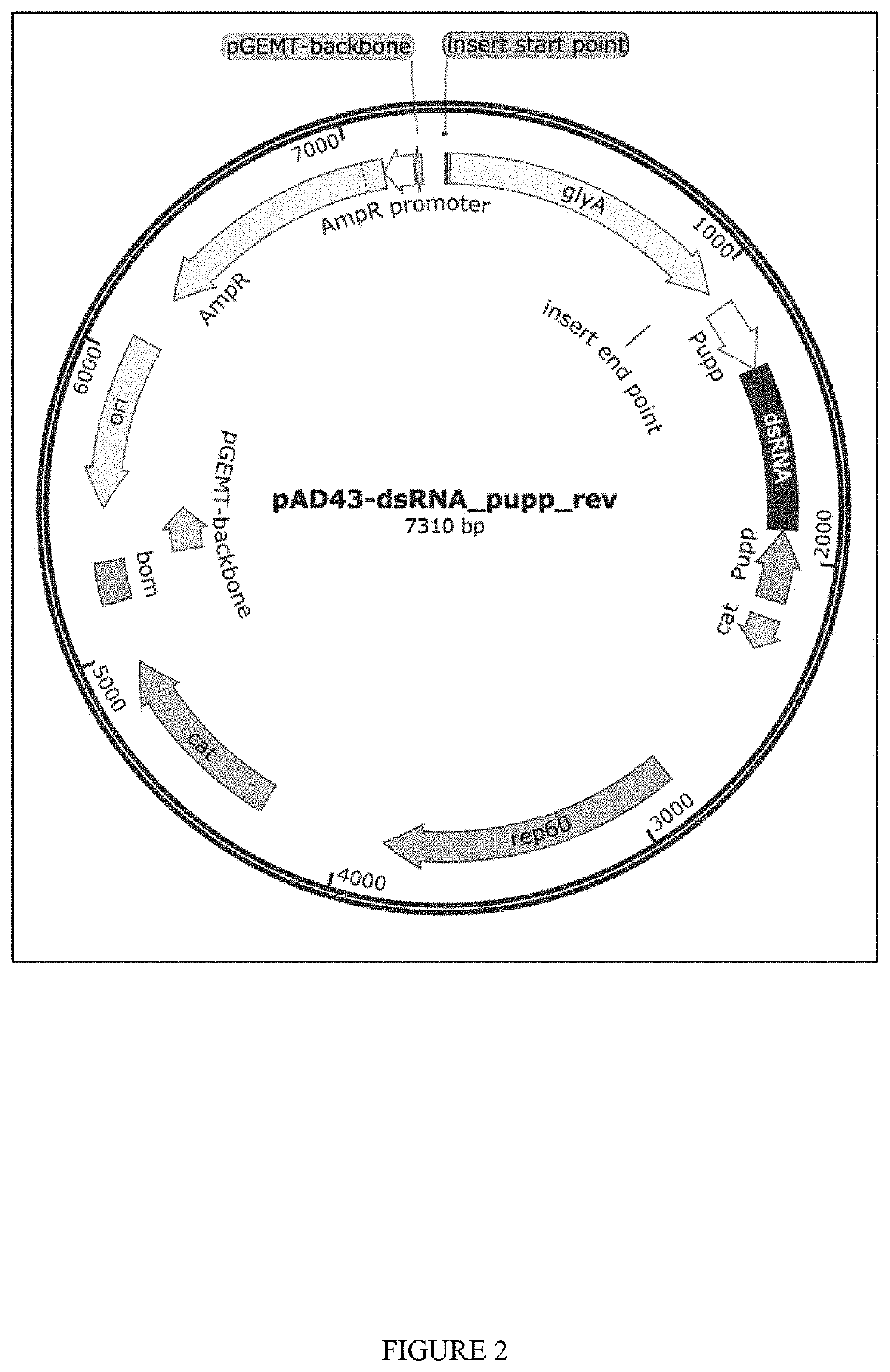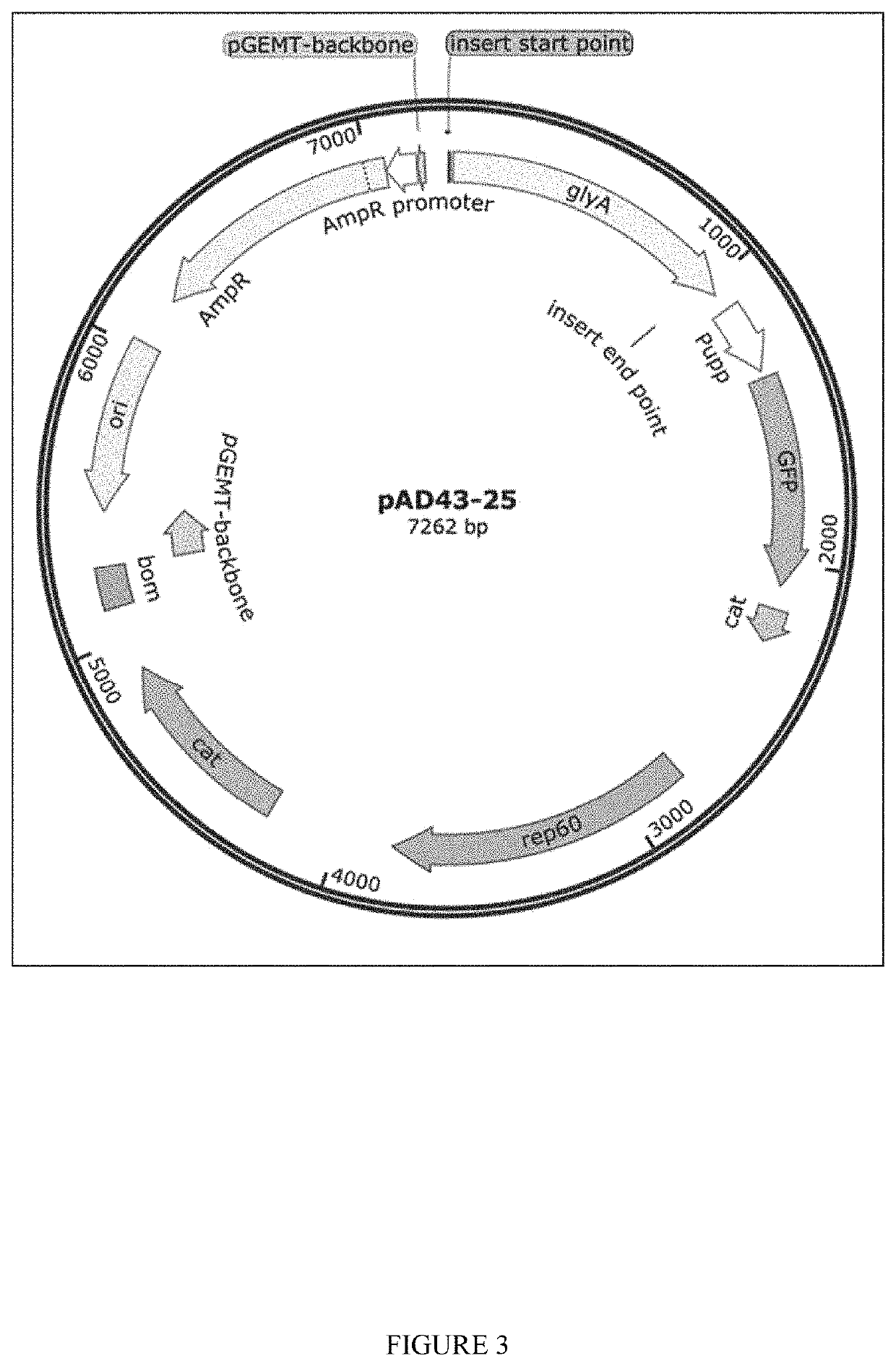Novel System for the Biocontrol of White Spot Syndrome Virus (WSSV) in Aquaculture
a biocontrol system and aquaculture technology, applied in the field of animal systems new strategies for disease control, can solve the problems of limiting the overall effectiveness of aquaculture, the associated risks of disease emergence and spread, and the continued global expansion of aquaculture, so as to facilitate the transmission enhance post-translational processing and/or modification of inhibitory rna molecules, and improve the delivery system of inhibitory rna
- Summary
- Abstract
- Description
- Claims
- Application Information
AI Technical Summary
Benefits of technology
Problems solved by technology
Method used
Image
Examples
example 1
n of Expression Vectors and Genetically Modified Bacterial Strain
[0148]Plasmids for dsRNA expression were made by cloning dsRNA sequence between 2 converging pUpp promoters in pAD-43-25 plasmid. As generally shown in FIGS. 2-3, PAD-dsRNA plasmid map and PAD-43-25 (pGFP expressing) plasmid map were generated by the present inventors. RNase III deficient Bacillus subtilis strain BG322 was transformed with pAD-dsRNA plasmids (3 plasmids for WSSV-specific dsRNA expression—pAD-dsWsv477 (SEQ ID NO. 1), pAD-dsVp28 (SEQ ID NO. 2), pAD-dsVp19 (SEQ ID NO. 3), and plasmid for expression of unspecific dsLuc pAD-dsLuc (SEQ ID NO. 4).
example 2
on of Shrimp Feed Containing Genetically Modified Bacteria
[0149]Bacteria were grown overnight in LB with 5 mg / ml chloramphenicol, and then centrifuged and mixed into a common commercial shrimp feed (Zeigler PL 40) at a concentration of 1E+08 CFU / gm feed and refrigerated. Prepared feed was fed to one gram shrimp at 10% body weight, divided into three feedings per day.
example 3
ion and Persistence of Genetically Modified Bacteria in Shrimp Intestine
[0150]The present inventors have demonstrated that the exemplary genetically modified B. subtilis strain BG322 is able to colonize and persist in shrimp intestines. In this embodiment, the present inventors transformed BG322 with plasmid pAD-43-25 encoding the fluorescent GFP protein. Shrimp were provided feed containing BG322 pAD-43-25 for 10 days and presence of BG322 was detected at days 5 and 10 by analysis of shrimp intestines under fluorescent microscope (GFP fluorescence detected in the intestines) and by plate count method (BG322 colonies were identified by GFP fluorescence) using isolated guts of shrimp. After 5 days of BG322 feeding the bacterial titer in the BG322 intestines was ˜1.1E+06 cfu / g and it stayed at approximately the same tier on day 10 (Table 1). Since the bacteria concentration in shrimp intestines became constant after 5 days of feeding, day 5 after feeding bacteria was chosen by the pre...
PUM
| Property | Measurement | Unit |
|---|---|---|
| Fraction | aaaaa | aaaaa |
Abstract
Description
Claims
Application Information
 Login to View More
Login to View More - R&D
- Intellectual Property
- Life Sciences
- Materials
- Tech Scout
- Unparalleled Data Quality
- Higher Quality Content
- 60% Fewer Hallucinations
Browse by: Latest US Patents, China's latest patents, Technical Efficacy Thesaurus, Application Domain, Technology Topic, Popular Technical Reports.
© 2025 PatSnap. All rights reserved.Legal|Privacy policy|Modern Slavery Act Transparency Statement|Sitemap|About US| Contact US: help@patsnap.com



